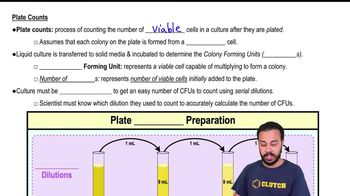Place the following in the order in which they are found in a host cell: (1) capsid proteins;
(2) infective phage particles; (3) phage nucleic acid.
a. 1, 2, 3
b. 3, 2, 1
c. 2, 1,3
d. 3, 1, 2
e. 1, 3, 2
 Verified step by step guidance
Verified step by step guidance



Place the following in the order in which they are found in a host cell: (1) capsid proteins;
(2) infective phage particles; (3) phage nucleic acid.
a. 1, 2, 3
b. 3, 2, 1
c. 2, 1,3
d. 3, 1, 2
e. 1, 3, 2
Plant viruses can’t penetrate intact plant cells because (a) ________; therefore, they enter cells by (b) ________. Plant viruses can be cultured in (c) ________.
Which of the following does not initiate DNA synthesis?
a. a double-stranded DNA virus (Poxviridae)
b. a DNA virus with reverse transcriptase (Hepadnaviridae)
c. an RNA virus with reverse transcriptase (Retroviridae)
d. a single-stranded RNA virus (Togaviridae)
e. none of the above
Define the following terms, and give an example of how each reaction is used diagnostically:
a. viral hemagglutination
b. hemagglutination inhibition
c. passive agglutination
Use the following choices to answer questions 7–9.
a. direct fluorescent antibody
b. indirect fluorescent antibody
c. rabies immune globulin
d. killed rabies virus
e. none of the above
Test used to identify rabies virus in the brain of a dog.
Use the following choices to answer questions 7–9.
a. direct fluorescent antibody
b. indirect fluorescent antibody
c. rabies immune globulin
d. killed rabies virus
e. none of the above
Test used to detect the presence of antibodies in a patient’s serum.